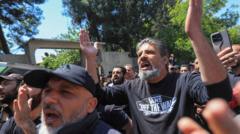When the gunfire erupted outside her home in the Damascus suburb of Ashrafiyat Sahnaya, Lama al-Hassanieh felt compelled to seek refuge in her bathroom, clutching her phone for safety. As armed fighters clashed in the streets below, their chants of "Jihad against Druze" struck terror into her heart. This marked just one instance in a series of violent sectarian conflicts targeting the Druze, a unique religious group that stems from Shia Islam and has historically held a fragile position within Syria’s shifting political landscape.
Under Bashar al-Assad's regime, many in the Druze community aligned with the government, believing it would shield them from violence ripping through other regions. Their hope was further sustained by the regime's reluctance to crack down on Druze dissent—unlike the aggressive responses seen in other areas of protest. However, allegiances have shifted as the Assad government faces challenges from Sunni Islamist-led rebel factions, leaving the Druze increasingly vulnerable to attacks from extremist militias.
The situation escalated dramatically after a fabricated audio recording surfaced, allegedly featuring a Druze leader making inflammatory remarks about Islam. Despite the leader's denial and the Syrian government labeling the recording as false, violent retaliations ensued. A surge of attacks across various Druze communities resulted in significant casualties, with over 137 individuals killed in just a few days of sectarian strife, according to the Syrian Observatory for Human Rights.
Pharmacy student Lama Zahereddine, who faced violence at her university, recalled a day when chaos erupted in her village, forcing her to flee under fire. The traumatizing experience stayed with her, prompting her to question safety and solidarity within her community. Many Druze, including Lama, now grapple with the fear of being betrayed by those around them, as classmates responded mockingly to their struggles.
Amid the violence, Druze individuals like Hadi Abou Hassoun attempted to mount a defense of their communities, only to become targets themselves. Hadi sustained severe injuries during an ambush, illustrating the extreme hazards faced by those trying to protect their heritage.
Despite the Syrian government's insistence on the unity and sovereignty of all citizens, the trust of minorities in state protection remains fragile and strained. Meanwhile, regional dynamics complicate the Druze plight, as international actors like Israel engaged in airstrikes, citing the need to protect the Druze from threats in their homeland.
As calmness lingers yet remains cautious in Ashrafiyat Sahnaya, Lama al-Hassanieh reflects on the breaking of trust within both her community and the state. Her calls for justice resonate through the worries of many who desire recognition as equal citizens in a nation that currently seems intent on dividing its populace along sectarian lines. The plea of the Druze is clear: They seek equal rights and accountability for those who threaten their safety, hoping for a peaceful coexistence in a fractured Syria.



















